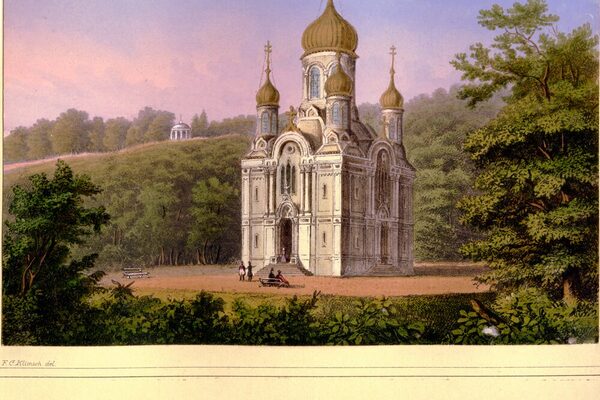Russian Orthodox Church of St. Elisabeth
The Russian Orthodox Church of St. Elisabeth on the Neroberg, a romantic historicist building, was built in 1846-55 as a burial church for Duchess Elisabeth of Nassau, who died in childbirth on January 28, 1845. With the consent of Tsar Nicholas I, the duke obtained the money for the construction of the church from her dowry. The master builder Philipp Hoffmann was entrusted with the task. In the winter of 1846/47, an eight-week trip took him to St. Petersburg and Moscow, where he devoted himself to both contemporary and Russian Renaissance church architecture. Two further trips took him to Italy in 1849/50 and 1852 to study the interior design of church interiors and at the same time to commission work for the church in Wiesbaden. Hoffmann planned the construction of the Russian Orthodox Church himself, down to the last detail, both inside and out. On May 25, 1855, after seven years of construction, the church was consecrated. The remains of the Duchess and her daughter were transferred from St. Boniface's Church to the new Russian Orthodox Church with great participation from the people of Wiesbaden.
The light sandstone church is a central building with five gilded domes supported by lanterns in the typical Russian onion shape. The ground plan is developed from a square with an inscribed Greek cross. The central dome is located above the central main room, which is adjoined on the outside by four side rooms, the arms of the cross. Four smaller domes are located above the corner towers. The sculptor Emil Alexander Hopfgarten created the medallions above the two entrances. The marble-clad church interior is extremely richly furnished and decorated. Opposite the entrance is the three-storey iconostasis (icon wall), which separates the congregation's meeting room from the chancel. The design of the iconostasis also goes back to Hoffmann, while the paintings (icons) were created by Carl Timoleon von Neff. The frescoes in the dome were painted by August Hopfgarten (1807-1896) from Berlin, a cousin of Emil Alexander Hopfgarten. A polygonal extension adjoins the northern side room, in which the cenotaph of the Duchess made of white Carrara marble stands, created by Hopfgarten in the style of Christian Daniel Rauch's funerary monument to Queen Luise of Prussia. The cenotaph with the reclining figure of the Duchess is adorned with the figures of the twelve apostles and, in the corners, four female figures symbolizing faith, hope, love and immortality. The actual resting place of the Duchess and her daughter is in the crypt below. To the north-east of the church, a sexton's house and the Russian cemetery were also built and laid out in 1855/56 according to plans by Hoffmann.
The church became the center of the Russian Orthodox community, which had existed since 1844, and of the Russian spa guests. A permanent congregation only emerged in the 1920s, when many Russian emigrants came to Germany as a result of the Russian Revolution and the Communists' seizure of power. The church has belonged to the Russian Orthodox Diocese of Berlin and Germany since 1936. The interior of the church was completely restored in the 1990s; in 2007, the domes were re-gilded on the occasion of the "Petersburg Dialogue" and the German-Russian summit held in Wiesbaden.
Literature
The Russian Church in Wiesbaden. Landmark of solidarity. HERUS e.V. - Hessian-Russian Intercultural Exchange and Humanitarian Aid (ed.), Wiesbaden 2013.
Philipp Hoffmann (1806-1889). A Nassau master builder of historicism. Ed.: Landesamt für Denkmalpflege Hessen, Stuttgart 2007 (Arbeitshefte des Landesamtes für Denkmalpflege Hessen 12) [pp. 57-63; 132-150].

